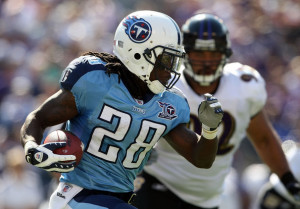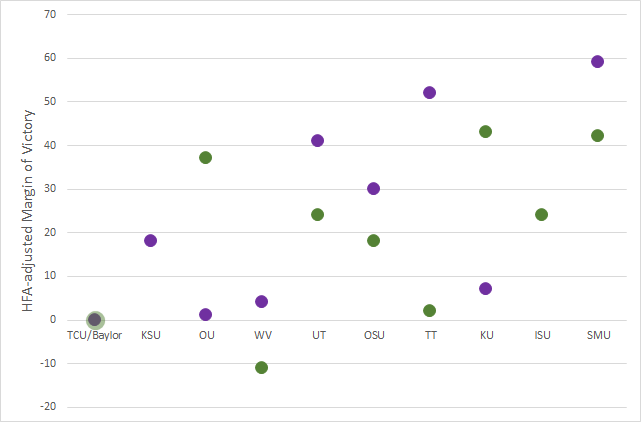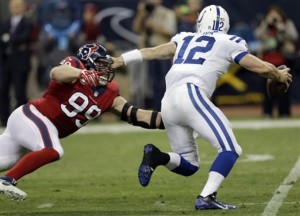Earlier this year, I noted that the Seahawks were operating at a historic level when it came to yards per carry differential. Seattle hasn’t slowed down since then: through 15 games, the team has rushed 491 times for 2,630 yards, a 5.36 YPC average. Defensively, the Seahawks have allowed just 1,262 yards on 362 carries, which translates to an anemic 3.49 YPC average. As a result, the team is averaging 1.87 more yards per carry than its opponents, which would place them second since 1950 behind the 2007 Vikings.
Over the last 30 NFL seasons, just one team has rushed for 2800 yards: the 2006 Atlanta Falcons, in the year where Michael Vick rushed for over 1,000 yards. Seattle has a good chance of being the second such team, thanks in no small part to Russell Wilson and his 842 rushing yards. Seattle’s rushing offense has been absurdly dominant this year, but that’s fodder for another day. Today I want to look at rush defense, and there’s another NFL team having a dominant season in that regard.
The Detroit Lions haven’t allowed a 100-yard rusher this year. Through 15 games, 31 NFL teams have allowed at least 1200 rushing yards, while Detroit has given up just 957 yards on the ground. That’s only 63.8 rushing yards per game, which would rank 4th among all teams since 1950, behind only the 2000 Ravens, 2006 Vikings, and 2010 Steelers. Detroit would need to allow just 46 yards against the Packers to pass the Steelers for 3rd place, 27 yards to pass the Vikings for 2nd, or 12 yards to pass the Ravens for first place. Okay, that probably won’t happen, but Detroit has been outstanding against the run this year. The Lions have been even better in the second half of the season against the run, allowing just 52.1 yards per game on the ground over the team’s last seven games.
And here’s a bit of good news for NFL fans: we could be heading towards a tremendous showdown or two in the postseason. Assuming the Packers beat the Lions on Sunday, Detroit will fall to the sixth seed in the NFC, which would likely mean a trip to Dallas — and NFL leading rusher DeMarco Murray — in the first round. And if the Lions win that game, the second round would have them headed to Seattle to face the Seahawks unstoppable rushing attack, if Seattle beats the Rams in week 17.
Detroit is one of just two teams this year that has not allowed a 100-yard rusher; the other is Baltimore, and the Ravens have not allowed a 100-yard rusher in 25 games, dating back to week six of the 2013 season (when Eddie Lacy rushed for 120 yards). That makes the Ravens just the 34th team since 1960 to go 25 games without allowing a 100-yard rusher; of course, for Baltimore, they need to extend the streak into the 2016 season to break the franchise record of 46 straight games.
It feels as though the Ravens have had a great run defense for the team’s entire history, courtesy of Ray Lewis and a host of talented rush defenders. As it turns out, Baltimore has allowed just 44 100-yard games since entering the league in 1996, but that’s only the second best mark. Over that same time period, the Steelers have allowed just 36 100-yard rushing games.
Baltimore’s run defense was nothing special in the early days of the franchise, while the mid-’90s Steelers run defense was dominant. If we look back just to 1999, the Steelers have allowed 33 100-yard rushers, while the Ravens have allowed only 32. Then again, change the cut-off to 2000, and Pittsburgh drops to 28, with Baltimore staying at 32.
Undoubtedly the most impressive part of the streak from either franchise belongs to Pittsburgh. From 2004 to 2010, the Steelers allowed just five 100 yard rushers. That’s mind-boggling. Among all teams since 1978, the only team other than Pittsburgh to allow fewer than ten 100-yard rushers over any seven-year period was the ’82 to ’88 Bears, who allowed nine.
Rudi Johnson hit the century mark in week four of the 2004 season; over Pittsburgh’s next 53 games, only Edgerrin James (124 yards in a 26-7 Colts win in 2005) rushed for 100 yards against the Steelers. In 2007, Thomas Jones and Fred Taylor each did it in the second half of the year, and then that was it until Ray Rice in week 16 of the 2009 season. No 100-yard rushers allowed in either the 2008 or 2010 season.










